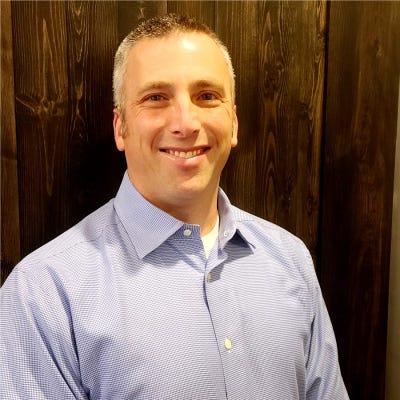Getting People Back into a Flexible Workspace Requires Flexible Design ImplementationsGetting People Back into a Flexible Workspace Requires Flexible Design Implementations
How well design decisions made at the beginning of the return-to-work push hold up in today's working climate is an open question.
July 3, 2023

Editor's Note: As part of our coverage on the new world of work, we'll be running recaps of virtual events from the NeoCon commercial design event, which took place from June 10-12, 2023.
In the NeoCon session "PandemicPivot in 4 Big Moves: Salesforce's Journey to Reimagine the Workplace (on an in-flight project!)," Melanie Lowe, Director, Global Workplace Design at Salesforce, and Pietro Silva, LEED AP, Design Director, Principal, IA Interior Architectsdovedeep into the ohanadesign philosophy behind one of Chicago's newest skyscrapers, the Salesforce Tower, a 57-story building which stands 813 feet tall, at the confluence of the three branches of the Chicago River.
Lowe said that over the past three years, she and her team (which includes Silva's IA), tested, learned and generated feedback from design projects all over the world. The nearby graphic illustrates the various iterations which culminated in the Chicago tower.
the design journey so far.png

Note the reference to Global Design Standards which Lowe referred to as their health and sustainable materials program which details how Salesforce measures the health and sustainability in its spaces and is publicly available.
Lowe said that a great deal of survey and focus group data drove the design decisions she and her team made both in those early iterations and in the Chicago tower. And that's something Silva said his company was able to help with since they had insights from other companies and other industries who were involved in the same process Salesforce was — figuring out how to design a flexible workplace for the post-pandemic world.
How to get people back into that flexible workplace was another problem Salesforce has been working.
When work began on the Salesforce Tower began in 2018 today's emphasis, at least among office workers, on remote and hybrid work was more exception than rule. Although, Salesforce has stated that historically about "18% of its employees have worked remotely, and today, that number has increased to 27% — and rising" as the company continues innovating around how where its employees work. In February 2023, the company introduced its "Return & Remote" guidelines which define four categories of teams: office-flexible, customer-facing, technical and remote. Each has different guidelines for how often individuals on those teams should be "in the office" — from several days per week to several days per quarter to none at all. Since then, according to that May 2023 post, "office attendance is up more than 40% globally."
In coming up with their core design tenets, Lowe's team used data from a variety of sources including anonymized badge and occupancy data, along with Google Insights data about usage of meeting rooms, as well as survey data which found that:
74% of respondents wanted to come back to collaborate with coworkers or clients and build that social connection they were missing.
16% said they still wanted a quiet space to focus on getting work done.
10% said they wanted "face time" with management — they want to learn from people in the office.
"Even though those percentages are low, I put them in here because it was one of our strategies we implemented because we know people want choice in the tasks that they're doing throughout the day in the office," Lowe said.
The ability to manage employees' spatial preferences was also a priority.
Many Salesforce employees "want to be able to come in when they want — 8, 9 or 10 o'clock in the morning — andbe able to find a desk, but not just find a desk anywhere," Lowe said. "They want to find a desk near their team because the reason they're in is to either to meet other people from other teams but also to work with the people that are closest to them on their teams."
The following graphic shows the seven core tenants that were developed out of this process.
renewed purpose of the office.png

From these core tenets, Silva said, came the idea of thinking about decentralization, of "flexibility as the overarching theme, of thinking it's a space that can expand and contract—¦a base that can change and modify—¦it's not static, and depending on where you are and what you need, the space can adapt to that. Everything is part of the neighborhood."
The following illustrates the difference between the current standard's "sea of desks" and the Neighborhood standard where there is a choice of workstyles that suit how people may choose to work differently, either all of the time or part of the time.
neighborhood redesign.png

The following photos are of the space in the Chicago tower, and it shows what the neighborhood design looks like — from the different workplaces, with desks, chairs along the windows, the interior "pod" areas that break up both how sound carriers and sight linesso the space doesn't look like a "sea of desks."
grass like flooring.png

The use of green, grass-like flooring and the different textures and workspaces in this other area of the same floor is shown here. Note how the natural light is a shared resource and you can see from one end of the space to the other, but the sight lines are varied.
"We had very much been inspired by nature and Biophilia and bringing the outside in so we do have grass carpet under underneath our desks as well as a lot of wood, natural wood finishes — all of our plants are real for example," Lowe said. "We have a lot of those elements in the space which makes it really warm and friendly."
different spaces to work.png

How the design team tried to provide employees with different places to work is illustrated in the following graphic:
Orange and red areas are the team and/or community space, to be used both for socializing and collaboration.
Blue and purple areas are the "heads down, focus space"—“ like libraries, but without books.
The green areas are for audio-visual, whether its individual, team, or company-wide collaboration and/or meetings.
Lowe noted that the Chicago Salesforce tower does not have raised floors, so they don't have that kind of flexibility when it comes to rearranging power outlets, for example. "So we have these mobile power units that people can bring wherever they want to go," she said, "if they need power in the particular area that they're sitting in."And that feeds into the concept of enabling neurodiversity in the workplace.
neurodiversity in the workplace.png

"We know that 15 to 20% of people, on average,are neurodiverse in some way,which just means, basically, they want a little bit more control around their workspace" Lowe said, "So it's not really difficult in the Chicago floor plan really to walk around and find the place that you want to work at any given time and that is universal for everybody that's on the floor."
The following graphic shows some of the AV technology deployed in the Salesforce tower, from conference rooms and digital whiteboards to AV phone rooms.
"Currently, all of our phone rooms are unbookable. Sothey'redrop in and we ask that people just drop in there for their meetings for 30 or 60 minutes and then move on back onto the desk or whatever area they want to work from," Lowe said."But we wanted to create a comfortable space that felt like your home setup, so we added a second screen, a lamp and a riser for your laptop."
phone room options.png

Lowe said that they also have Google Jamboards which can be used for different meeting and collaboration in the various spaces. "Our business technology team have also been upgrading all of our cameras, and microphones and speakers in all of our meeting rooms as we go."
The following two photos are of the new space itself, the ones dedicated for social lounges, but note the large screens that can be used for different meetings and events.
"Day to day it's more of a casual sofa gatheringplace and you can see that there's lots of different seating in this lounge," Lowe said. "But those chairs in the lounge can be reassigned to other spaces so you could have an all hands meeting or a town hall with everybody facing towards the screen."And that's actually how the chairs are arranged in the second photo.
social lounge 1.png

social lounge 2.png

One key thing to remember is that most of these design decisions were made 18 months ago, Lowe said, so they don't really know if they made the right decisions.But they did make the best decisions they could at the time with the information they had at hand — all of the surveys, focus groups, badge data, etc., that was mentioned earlier.
"So if that team of people who've come into the office can't find seats near each other, it really feels like, shoot, maybe I should have organized that better," Lowe said. "Those are things I think we're all going to find to be a challenge as more people come back to the office."
About the Author
You May Also Like





